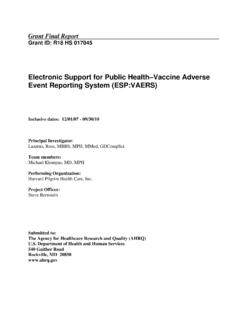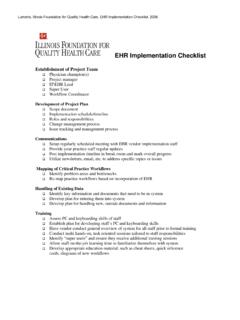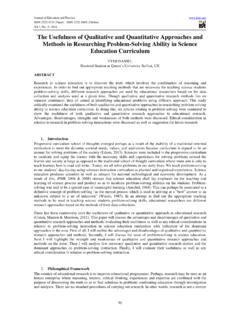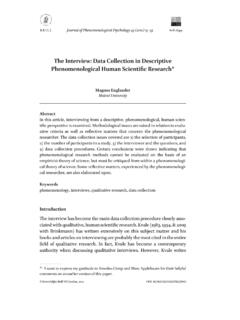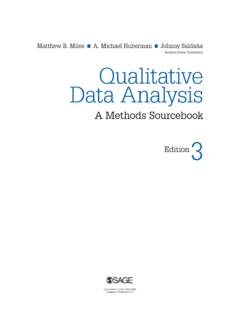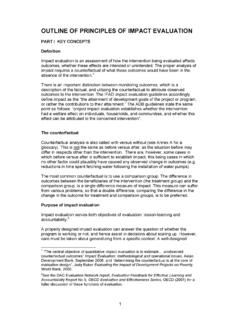Transcription of Quality Performance Monitoring, Data Collection, and …
1 Fi nal C ontract Report Quality Performance Monitoring, data collection , and Reporting Report of Experiences From Primary Care Practices in the Virginia Ambulatory Care Outcomes Network Final Contract Report Quality Performance Monitoring data collection and Reporting Report of Experiences From Primary C are P ractices i n t he Virginia Ambulatory Care Outcomes Network Prepared for: Agency for Healthcare Research and Quality Department of Health and Human Services 540 Gaither Road Rockville, MD 20850 No. HHSA 290-2007-10011-2 Prepared by: Virginia Commonwealth University Department of Family Medicine Richmond, VA Authors: Daniel R.
2 Longo, Stephen F. Rothemich, , Alex H. Krist, , Sharon K. Flores, Shenise J. Loney, , Charles O. Frazier, , FA AFP Nancy C. Elder, , Barbara A Wright, , AHRQ Publication No. 15- 0024-EF April 2015 This document is in the public domain and may be used and reprinted without permission except those copyrighted materials that are clearly noted in the document. Further reproduction of those copyrighted materials is prohibited without the specific permission of copyright holders. Suggested Citation: Longo DR, Rothemich SF, Krist AH, et al.
3 Quality Performance Monitoring, data collection , and Reporting: Report of Experiences From Primary Care Practices in the Virginia Ambulatory Care Outcomes Network. (Prepared by the V irginia Commonwealth University under Contract No. HHSA 290-2007-10011-2.) A HRQ Publication No. 15- 0024-EF. Rockville, MD: A gency for Healthcare Research and Quality . April 2015. None of the investigators has any affiliations or financial involvement that conflicts with the material presented in this report. This project was funded by the Agency for Healthcare Research and Quality (AHRQ), Department of Health and Human Services.
4 The opinions presented here are those of the authors and do not necessarily reflect the position of the Department of Health and Human Services or the Agency for Healthcare Research and Quality . ii Acknowledgments The authors thank the practices in the Virginia Ambulatory Care Outcomes Research Network (ACORN) for their participation. We also thank the members of the project's expert panel: James Galliher, ; Jacob Jones, , ; Wilson Pace, ; Greg Pawlson, ; Kevin A. Peterson, , , FRCS(Ed), FA AP; Robert L. Phillips, Jr., , ; and Martha C.
5 Samuel, Their conceptual input was extremely helpful. We gratefully acknowledge Brian J. Bush, , VCU Biostatistical Research and data Services, f or development of the interactive Web tool. Finally, the study received extensive support from AHRQ Project Officer David Lanier, iii Structured Abstract Overview. Primary care practices are aware of the importance of Performance monitoring to track patient outcomes and receive reimbursement for improved care management. However, a lack of experience with comparative data analysis, a lack of familiarity with or access to information technology resources, and inadequate reimbursement for related activities has limited progress toward this end.
6 Primary care clinicians are faced with multiple competing practice demands for their time that limit their ability to become fully engaged in Quality Performance monitoring, data collection , and reporting (QPMDCR). Design. Primary care practices in the Virginia Ambulatory Care Outcomes Research Network (ACORN) were invited to conduct QPMDCR projects of their own choosing in an effort to identify and document barriers faced by primary care practices as they attempt to conduct Performance monitoring. A review of the literature from 1989 to 2009 was also conducted.
7 Population. Participating practices represented a range of practice size, patient population, resources, medical record systems (electronic or paper-based), and experience with Quality improvement activities. Methods. Six ACORN practices were selected to conduct projects based on their level of interest and commitment and their ability to respond to the demands of the project timeline. Each practice selected a project to be completed during the 6- month implementation period (July - December 2008); independently, all six practices chose to focus their efforts on issues related to diabetes care.
8 Practices were provided with guidance by the Task Order Principal Investigator and a network Practice Liaison through face-to-face, telephone, and email consultation. Focus groups were held at the mid-point and conclusion of the study period to gather qualitative feedback. Also, taking a comprehensive approach the research team conducted a search for relevant studies in multiple electronic databases from 1980 to 2009 using the MESH term " Quality of health care" combined with additional MeSH terms and text words data collection , reporting, monitoring, and measuring, as well as primary care.
9 Retrieved articles were classified by article type (medical literature or other sources, such as Web sites or press releases) and how directly they addressed primary care Quality Performance monitoring. Over the course of the task order, the te am identified 39,837 potential articles; however, only 75 directly addressed primary care Performance monitoring and 108 addressed Performance monitoring in other health care fields. An additional 256 specifically addressed various "tools and techniques" applicable to Performance monitoring, and another 173, largely from business and industry, addressed future trends.
10 Findings. Five of the six practices completed implementation of QPMDCR projects; one practice began the planning stage but was unable to complete implementation. Practices experienced multiple barriers in their efforts to conduct Performance monitoring, including lack of expertise in systematic collection and analysis of data , access to actionable data systems, iv clinician engagement and support for Performance data collection , and resources to support time and staff necessary for data collection . Conclusion. Many factors affect the ability of primary care practices to effectively carry out Performance monitoring activities.
